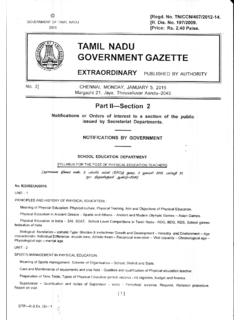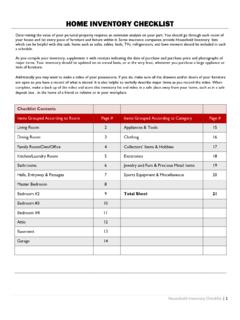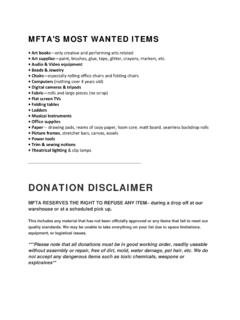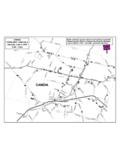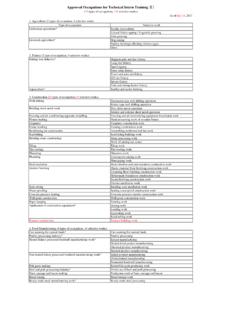Transcription of Implementation of Lean Manufacturing Tools in …
1 Naresh Paneru Implementation of lean Manufacturing Tools in Garment Manufacturing Process Focusing sewing Section of Men s Shirt Implementation of lean Manufacturing Tools in Garment Manufacturing Process Focusing sewing Section of Men s Shirt Naresh Paneru Master s thesis Autumn 2011 Degree Programme in Industrial Management Oulu University of Applied Sciences 4 Author: Naresh Paneru Title of Thesis: Implementation of lean Manufacturing Tools in garment Manufacturing process focusing sewing section of Men s Shirt Thesis Supervisor: Hannu P talo Degree: Degree Programme in Industrial Management Graduation Year: Autumn, 2011 Number of Pages: 72 + 8 ABSTRACT Traditionally operated garment industries are facing problems like low productivity, longer production lead time, high rework and rejection, poor line balancing, low flexibility of style changeover etc.
2 These problems were addressed in this study by the Implementation of lean Tools like cellular Manufacturing , single piece flow, work standardization, just in time production etc. After Implementation of lean Tools , results observed were highly encouraging. Some of the key benefits entail production cycle time decreased by 8%, number of operators required to produce equal amount of garment is decreased by 14%, rework level reduced by 80%, production lead time comes down to one hour from two days, work in progress inventory stays at a maximum of 100 pieces from around 500 to 1500 pieces. Apart from these tangible benefits operator multi-skilling as well as the flexibility of style changeover has been improved.
3 This study is conducted in the stitching section of a shirt Manufacturing company. Study includes time studies, the conversion of traditional batch production into single piece flow and long assembly line into small work cells. Key Words: lean Manufacturing , Just In Time, Cellular Manufacturing , Time study, Single Piece Flow ACKNOWLEDGEMENTS I would like to thank the Oulu University of Applied Science for giving me the opportunity to pursue Master s Degree in Industrial Management. I would like to thank my supervisor, Hannu P talo for his continued support throughout the course of this thesis. Similarly, I would like to express my genuine appreciation for senior lecturer Mr.
4 Tauno Jokinen who guided me throughout this thesis process. I am obliged to all seniors and juniors in the industry, who coordinated and helped me directly or indirectly during the research process. 5 6 CONTENTS 1 INTRODUCTION .. 12 Background .. 12 Research Problems .. 13 Research Objective .. 14 Research Approach .. 15 Report Construction .. 16 2 LITERATURE REVIEW .. 17 History of lean .. 17 Definition of lean .. 18 lean Principles .. 18 Toyota Production System .. 19 Kind of Wastes .. 21 lean Manufacturing Tools and Techniques .. 22 Cellular Manufacturing .. 22 Continuous 24 Just in Time .. 25 Total Productive Maintenance .. 28 Waste Reduction Techniques.
5 31 Value Stream mapping .. 32 Method Study .. 33 Labor Standards and Work Measurements .. 33 Historical Experience .. 34 Time Studies .. 34 Predetermined Time Standards .. 36 Work Sampling .. 36 7 Layout Design .. 38 Assembly Line Balancing .. 39 Takt Time .. 40 Cycle Time .. 41 Summary .. 41 3 GARMENT MANUFACTURIGN PROCESS .. 43 Industry Background .. 43 Garment Manufacturing Process .. 44 Cutting 44 Preparatory Section .. 44 Assembly 47 Finishing Section .. 48 Style Communication .. 49 Existing Production Layout .. 49 WIP Movement System .. 51 4 RESEARCH OF THE EXISTING PRODUCTION .. 52 Conducting Time Study .. 52 Creating Cellular Layout.
6 53 Work Balancing between Operators .. 54 Critical Operation Handling .. 56 Trial Production on New Layout .. 58 5 RESULT ANALYSES .. 59 Throughput Time Comparison .. 59 Comparison of Production Time .. 60 Comparison of Number of Operation .. 61 Comparing Number of Operator Required .. 62 Comparison of Information Flow .. 64 8 Comparison of Rework Level .. 64 Operator Skill Improvement .. 65 Operator Motivation .. 65 6 RESEARCH SUMMARY .. 66 Conclusion .. 66 Limitations of the Study .. 67 Recommendation for Future Research .. 68 7 LIST OF REFERENCES .. 70 8 LISTS OF APPENDICES .. 73 9 LIST OF TABLES Table 1: Difference between Push and Pull Manufacturing Table 2: Section wise Number of Operation and Number of Operator requirement.
7 57 10 LIST OF FIGURES Figure1: Toyota Production Figure 2: Pillars of Figure 3: Garment Production Process Flow Figure 4: Cutting Section Production Flow Figure 5: Preparatory Section Production Flow Figure 6: Assembly Section Production Flow Figure 7: Finishing Section Production Flow Figure 8: Existing Production Layout of Stitching Figure 9: Recommended Stitching Section Figure 10: Comparison of Production Time for Different Stitching Figure 11: Comparison of Number of Operation in Different Figure 12: Comparison of Number of Operator Required in Different 11 ABBREVIATIONS CAD Computer Aided Design CAM Computer Aided Manufacturing CI Continuous Improvement FSVSM Future State Value Stream Mapping ISVSM Ideal State Value Stream Mapping JIT Just in Time MTM Methods Time Measurement PDCA Plan Do Check Act PFD Personal Fatigue and Delay PMTS Predetermined Motion Time Systems PSVSM Present State Value Stream Mapping SAM Standard Allowed Minutes SMED Single Minute Exchange of Dies TMU Time Measurement Unit TPM Total Productive Maintenance TPS Toyota Production System VSM Value Stream Mapping WIP Work in Progress 12 1 INTRODUCTION Background Due to the
8 Increasing labor wage in developed countries, the apparel Manufacturing has been migrating from the high wage developed world to low wage developing countries (Bheda, Narag and Singla, 2003). Even though the labor cost is cheaper than in developed countries; due to the specific market nature of the garment industries for example: the short production life cycle, high volatility, low predictability, high level of impulse purchase, the quick market response; garment industries are facing the greatest challenges these days (Lucy Daly and Towers, 2004). Garment industries in developing countries are more focused on sourcing of raw material and minimizing delivery cost than labor productivity because of the availability of cheap labor.
9 Due to this, labor productivity is lower in developing countries than in the developed ones. For example, labour is very cheap in Bangladesh but the productivity is poor among other developing countries (Shahidul and Syed Shazali, 2011). Similarly, the cost of fabric is a major part of the garment so there seems to be great need for improvement in this sector. Even in developing countries the CAD and CAM system for fabric cutting has been implemented to save fabric. Now the worry is about labor productivity and making production flexible; because the fashion industry is highly volatile and if the orders are not fulfilled on time, the fear for losing business is real.
10 Even today, industries are getting the same or more volumes (orders), but the number of styles they have to handle has increased drastically. Earlier industries were getting bulk order so there is no need to worry; if the production line was set for the first time it would run for a month or at least a week or two. But nowadays due to small order quantities and complex designs, the garment industry has to produce multiple styles 13 even within a day; this needs higher flexibility in volume and style change over (Shahram and Cristian, 2011). In some cases it has been observed that, in developing countries the garment industries are run as family business lacking skilled personnel as well as capital to implement new technologies for improving productivity and flexibility.


